![]() This week, we continue our series on the search for the ideal battery to power Yoctopuce modules, especially when driven by a YoctoHub which can go into sleep mode. This is important, because standard USB batteries have the unfortunate habit of shutting down completely as soon as the hub goes to sleep. After the success of variant (C) of the Waveshare Solar Power Manager battery and the fiasco of variant (B), we decided to test variant (D), just to be sure.
This week, we continue our series on the search for the ideal battery to power Yoctopuce modules, especially when driven by a YoctoHub which can go into sleep mode. This is important, because standard USB batteries have the unfortunate habit of shutting down completely as soon as the hub goes to sleep. After the success of variant (C) of the Waveshare Solar Power Manager battery and the fiasco of variant (B), we decided to test variant (D), just to be sure.
Waveshare Solar Power Manager (Model D)
Model D takes the form of a small electronic board measuring around 40x45mm, with four 2.5mm-diameter mounting holes and 6 connectors.
- A screw terminal for the battery and a four-pole PH2.0 connector for the optional 18650 battery holder. You can choose to use one or the other.
- A screw terminal and a DC-002 round connector for an external power supply or solar panel - you can use either one, they're wired in parallel.
- A screw terminal for a 5V output
- A USB-C connector that can either be connected to a USB power supply or supply power to a USB module.
_1.jpg)
Waveshare Solar Power Manager (Model D)
Model D is available in two options: the circuit board alone, or the circuit board plus a battery holder. The battery holder enables the use of three 18650 li-ion batteries. Unlike most battery holders, this one is wired in parallel. In fact, it's exactly the same as variant (C).

Optional battery holder
The test
We ran our little experiment using a Yocto-Meteo-V2 driven by a YoctoHub-Wireless-n. The hub wakes up once every ten minutes, retrieves the temperature measured by the Yocto-Meteo-V2 and sends it to a server running an instance of VirtualHub for Web, then goes back to sleep. The operation takes an average of six seconds. When the hub is awake, system power consumption is around 100mA, whereas when asleep, it's around 15µA.
-expriment_1.jpg)
Our standard USB battery test
We used the same three 3400mA batteries as last time, and our experiment ran for 20 days and 5 hours before the system, running out of battery, decided to shut down completely. This is a marginally better result than variant (C).
The Waveshare Solar Power Manager (D) battery lasted 20 days and 5 hours
To resuscitate the system, all we had to do was apply around 5V to the power connector of the Waveshare Solar Power Manager (D) and everything was back to normal and the batteries began to recharge. The device accepts voltages up to 24V on its power supply, but seems to limit its maximum consumption to around 8.5W.
At first glance, the electronics of variant (D) are very similar to those of variants (B) and (C), but there are a few notable differences.
- Versions (B) and (C) have micro-switches to set the nominal voltage of the power supply used, typically a solar panel. They only start charging the batteries when the power supply voltage approaches the set voltage. Version (D), on the other hand, has no micro-switches and seems to be able to take care of itself.
- The LEDs on version (D) are much better managed. On versions (B) and (C), the LEDs indicating remaining battery capacity stay permanently lit, whereas with version (C) they are only lit when there is significant consumption. On the other hand, when the battery is almost empty, a LED flashes permanently to indicate the urgency of the situation.
Conclusion
The (D) variant of the Waveshare Solar Power Manager battery is an excellent solution for powering a Yoctopuce system. It offers good performance, is easy to integrate and lets you use the lithium batteries of your choice.
Overall, the different variants of the Waveshare Solar Power Manager are a good solution, each with its own advantages:
- Variant (B): Plug-and-play, potentially the cheapest, provided you manage to obtain a recently built model. As a reminder, early models switch themselves off.
- Variant (C): Plug-and-play, works with standard batteries that are easy to install and replace.
- Variant (D): easy to integrate into a system.
Finally, I'd like to mention Waveshare's technical support, which is extremely slow to respond and not necessarily very competent. But with persistence and patience, we finally got some constructive answers to our questions about the different variants.
Edit: here are quick links to the whole series of articles about USB batteries: Part 1 - Part 2 - Part 3 - Part 4


